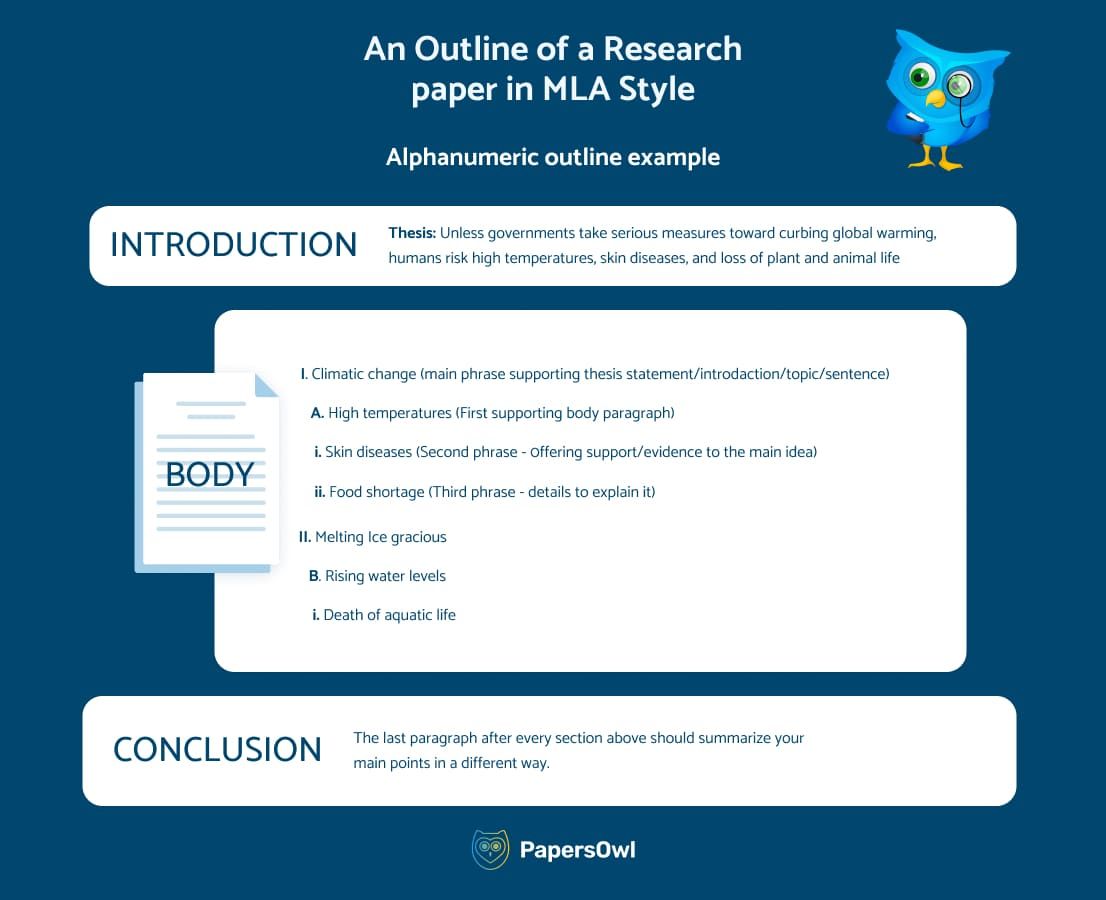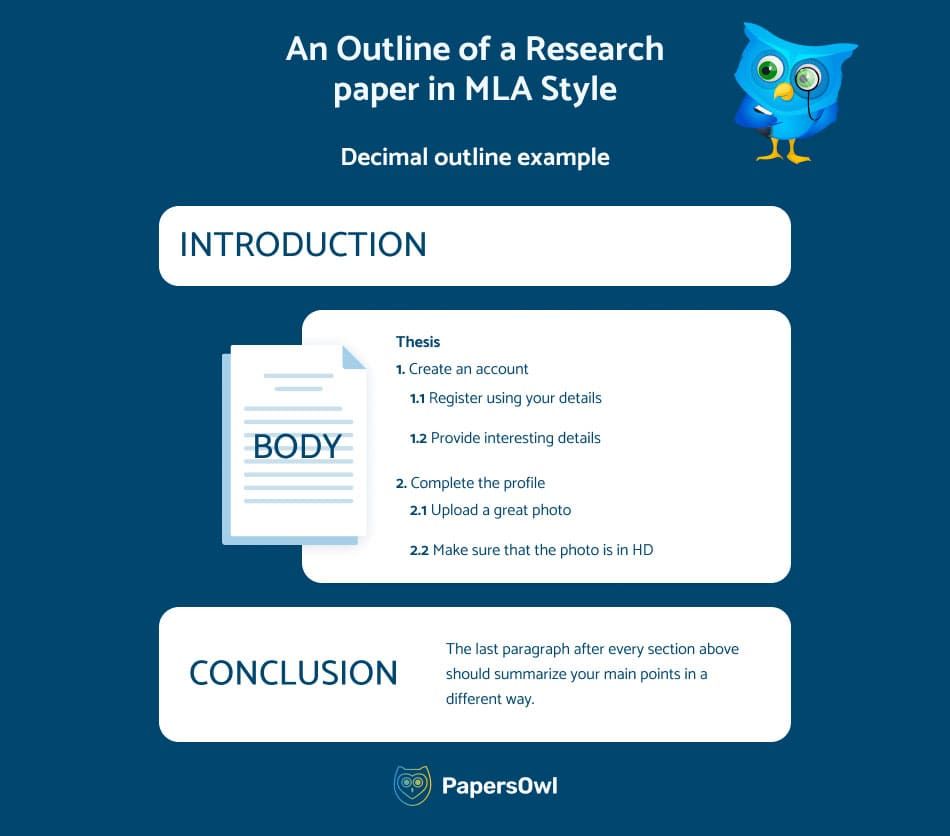How to Write an Outline of a Research Paper in MLA Style
Table of contents
The MLA format outline helps writers build structure before drafting. It works like scaffolding for your ideas. With it, your argument unfolds in a way that’s easy to follow.
You begin with a title, then move into your main outline. Each section uses uppercase letters, letters, or numbers to show levels of thought. The goal is clarity. Don’t overload it.
Follow the guidelines: double space, use 12pt Times New Roman, and number every page. Depending on the assignment, each part of the structure can be a full sentence outline or short phrase.
When you write an essay, you need more than words. You need a plan. The MLA structure gives just enough form to let your thoughts grow without boxing them in!

Basic Formatting Rules for MLA Outline Format
The MLA format outline follows a predictable shape. You start with a title, then move through numbered and lettered sections. Use uppercase and regular letters to layer your key points. Every page should follow set guidelines — double-spaced lines, standard 12pt font, and clear margins. Each thesis or paper plan can use a full sentence outline or short phrases. Read the full MLA research paper formatting guidelines if in doubt.
Thesis Statement in an MLA Outline
A thesis statement sits at the top of your MLA outline for research paper. It isn’t just a sentence — it’s the core of your argument. Keep it direct. Write it before you organize your key points. Every statement after it should circle back. It steers the discussion and gives shape to your paper. If you’re unsure where to start, a research paper writing service might help draft your direction.
Headings and Subheadings (Roman Numerals, Capitals, Arabic Numerals)
Each section in an MLA formatted outline has a clear purpose. Roman numerals (I, II, III) mark headings. Capital letters (A, B, C) tag subheadings. Underneath, Arabic numerals (1, 2, 3) add precision. You use this to organize and support ideas. Don’t confuse this with the APA outline format — MLA follows its structure. Keep it sharp. Each piece should write itself into the larger argument.
Indentation, Line Spacing, and Font Guidelines
Spacing shows care. An MLA format for an outline demands clarity: every level indents slightly more than the one before. Use two-line spacing, even in outlines. Keep the font readable — Times New Roman, size 12. The lowercase letters used in sections show order, not flair. See how to format an essay in MLA for a full style guide. Whether it’s a quick assignment or a full paper, organize it well and write precisely. That’s real MLA style.
Alphanumeric, Decimal, and Simplified Formats Explained
There’s more than one MLA outline example.
- The alphanumeric outline uses letters and numbers like I. A. 1. a.
- A decimal outline leans on numbers: 1.0, 1.1, 1.2.
- A simplified version sticks to I, II, III, with headings and subheadings only.
Pick what suits your paper best. Here’s a trick — start with a filled-in high-level example, drawn from sample MLA style outline templates. They help you write while keeping the discussion grounded and support in place. Explore various sample outlines to sharpen your draft.

How to Create an MLA Outline in 5 Simple Steps
- Step 1: Write a Clear Thesis StatementStart your MLA research paper outline with a solid thesis statement. It defines your main argument and shapes the entire layout. Keep it direct. Avoid clutter. A strong thesis tells readers what to expect from the beginning to your logical conclusion. If you get stuck, an essay writer can help present ideas clearly.
- Step 2: Add Main Headings Using Roman Numerals (I, II, III)Once the thesis is set, list your main headings with Roman numerals. These act like the bones of your argument. Each numeral shows a main point in the outline for research paper MLA. Label each heading clearly. Keep phrasing tight. You don’t need to create drama — just write with purpose.
- Step 3: Insert Subheadings with Capital Letters (A, B, C)Beneath each numeral, add subheadings with capital letters. These clarify your sections without excess detail. A subheading should highlight a part of your thesis or support it. Make sure each section is labeled and flows from the point above.
- Step 4: Add Supporting Details with Arabic Numbers (1, 2, 3)Now, layer in support using Arabic numbers. These points describe facts, examples, or quotes. They help convey your argument with structure. Think of them as roots feeding your main claim. This is how a MLA essay outline keeps things clear. Keep each item labeled and focused.
- Step 5: Check Formatting Consistency and Parallel PhrasingBefore you wrap, review your work for parallel phrasing. All parts of your layout should follow the same format. Sentences should match in tone and structure. Use full sentences or phrases — just not both. Good structure ensures your draft reads smoothly and feels complete. A polished research paper outline template MLA makes room for clean in-text citations later.
Sample Outlines in MLA Format
Alphanumeric Structure Example

The alphanumeric outline is the classic structure — organized by Roman numerals, Arabic numerals, capital and lowercase letters, often tucked into parentheses—and it suits most academic writing.
Topic: The Ethics of Terraforming
I. Introduction
A. Statement of Intent
1. Define terraforming as planetary-scale alteration
2. Mention Mars and current feasibility modelsB. Thesis: Ethical terraforming demands cautious advancement backed by long-term safeguards
II. Historical Context
A. Early theories in planetary science
B. Cold War-era space ambitions
III. Ethical Dilemmas
A. Risks to native biospheres (if present)
1. Unknown microbial life
2. Potential contaminationB. Human-centric biases in space planning
This outline helps present your main points with precision while keeping parts distinct.
Decimal Structure Example

The research paper outline example MLA can also follow a decimal outline format. Here, numbers mark levels instead of letters, like 1.0, 1.1, 1.2. Use it for clean, technical layouts.
Topic: Soil Health and Microbial Networks
1.0 Introduction
1.1 What is the soil microbiome?
1.2 Importance of sustainable food systems2.0 Chemical Inputs and Microbial Disruption
2.1 Effects of nitrogen-heavy fertilizers
2.2 Altered microbial diversity and soil decay3.0 Case Studies
3.1 Long-term soil health in overused cropland
3.2 Organic versus synthetic practices
This example uses Arabic numerals, perfect for reports heavy on data and abstract points.
Simplified Outline Example
The simplified version drops lower levels. Ideal for essays with broad strokes. Keep it to main headings and a few supporting ideas. No clutter, just structure.
Topic: Satellites and Weather Prediction
I. Introduction
A. Historical overviewII. Satellite data accuracy
B. Limitations in storm tracking
The structure here supports a short paper. Clean format, strong structure, and room to add a works cited page.
Sample Topic with Outline (Filled-In High-Level Sections)
Below is a topic sketched using the MLA format outline. This format works well for general assignments or a basic essay.
Topic: Indigenous Fire Stewardship
I. Overview of traditional practices
II. Fire as ecological balance
III. Loss of knowledge through colonization
IV. Revival efforts and policy reform
This model fits sample outlines that call for clear main points. It’s widely applicable and easy to write from when you’ve shaped your thesis.
MLA Outline Checklist
Before submitting your outline, go through this list. Each checked item helps your argument stand tall.
Creating an MLA research paper outline can make the writing process much easier. A clear outline helps you organize your paper around the three main sections — introduction, body, and conclusion. Before starting, be sure to use the correct edition of the MLA guidelines (such as the 8th or 9th edition) and review the manual to ensure your outline meets all formatting requirements.







